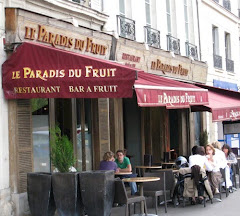
Then, into the next room for the wine tasting. Joe had laid out a dizzying array of 30 different fruit wines, all but one or two made by him. He handed out “score cards” for rating aroma and flavor, and challenged the tasters to determine which wines were from which fruits. At the start, the bottles were all wrapped in tin foil so the tasters couldn’t see which was which. I don’t know what the outcome was (if there was one), but everyone seemed to enjoy the process, and agreed that it is a little more difficult than one might think.

At the end of the tasting, he invited each of us choose a bottle of wine to take home.

After the tasting, we trooped outside where Joe talked for a while about how he grows bananas. It was warm, but there was a breeze and it was very pleasant. Below are some notes from his talk, incomplete and in no particular order, just to give you a taste:

If the pseudostem survives the winter, and blooms in late spring, it should fruit. When fruit is half-filled, cover it with a blue plastic bag to promote ripening.
He recommends keeping 3 stems to a clump: a main one, a medium one, and one pup.
Bananas like the temperature to be between 80 and 90 degrees F.
He adds 4 cubic feet of steer manure per clump per year, and fertilizes with K Mg or SulPoMag (not N) every 2 weeks until August. No fertilizer after that, so as not to encourage growth during the winter.
He waters twice a day, about 1 gallon per clump each time. Bananas have wide, shallow roots. It doesn’t matter if they blow over – they just keep growing.
After harvest, he recommends cutting just half off the pseudostem, and leaving the other half until it dies back. This gives time for the nutrients contained in the stem to translocate down to the corm.
Leave any dead leaves. In the winter they can be used to help wrap the stem to protect it from the cold. They should then be wrapped with something like jute netting. Not plastic – it holds water which can freeze. Then put Christmas lights around the whole bundle, and plug them in if it gets really cold. The stem should be wrapped just before the first frost, and unwrapped after the last one.
He recommends putting plastic at the base of the plant in the winter to divert water away from the trunk to prevent rot. Bananas are not growing during the winter, and are very drought tolerant during this time. They can be dug and left in the garage for 3 months, watering only once per month.
There is a variety called “California Gold” that is probably OK for cooler areas. He has a friend growing it in Pinole.
Don’t eat the flowers of Cavendish bananas – too much oxalic acid. Plantain or cooking types should be OK.
After a lot of banana questions, Joe took us on a tour of the rest of the garden. It looks innocent enough, until you begin to discover that he has grafted hundreds of varieties onto the various plants! 80 kinds of citrus on one tree. Apples, pears, many plums and pluots, apricots, guavas, grapes, 50 kinds of persimmons on one tree, grapes, blueberries, peaches, on and on.

Joe was a wonderfully gracious, generous and knowledgeable host – a big thank you from us all!

1 comment:
Ah...wish I could have made it. Not having a car really sucks sometimes.
Post a Comment